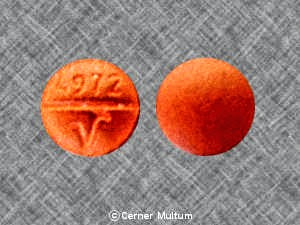PHENAZOPYRIDINE
(fen AY zoe PIR i deen) Brand: Azo-Gesic, Azo-Standard, Baridium, Phenazo, Prodium, Pyridiate, Pyridium, Re-Azo, Uricalm, Uristat









What is the most significant information I must know about phenazopyridine?
• Do not take this medicine if you are allergic to phenazopyridine, or if you have kidney disease.
• Phenazopyridine will treat the symptoms of a urinary tract infection, but this medicine does not treat the actual infection. Take any antibiotic that your doctor prescribes to treat your infection.
• To avoid stomach upset, take phenazopyridine with food.
• Phenazopyridine will most likely darken the color of your urine to an orange or red color. This is a usual effect and is not reason for alarm unless you have another symptoms such as pale or yellowed skin, fever, stomach pain, nausea, and vomiting. Darkened urine may also reason stains to your underwear, which may or may not be removed by laundering.
• Phenazopyridine can also permanently stain soft contact lenses, and you must not wear them while taking this medicine.
• Do not use phenazopyridine for longer than 2 days unless your doctor has told you to.
• Stop taking this medicine and call your doctor at once if you have pale skin, fever, confusion, yellowing of your skin or eyes, heighten thirst, swelling, or if you urinate smaller than normal or not at all.
What is phenazopyridine?
• Phenazopyridine is a pain reliever that affects the lower part of your urinary tract (bladder and urethra).
• Phenazopyridine is used to treat pain, burning, heighten urination, and heighten urge to urinate. These symptoms are generally caused by infection, injury, surgery, catheter, or another conditions that irritate the lower urinary tract.
• Phenazopyridine will treat the symptoms of a urinary tract infection, but this medicine does not treat the actual infection. Take any antibiotic that your doctor prescribes to treat your infection.
• Phenazopyridine may also be used for another purposes not listed in this medicine guide.
What must I discuss with my health care provider till taking phenazopyridine?
• Do not take this medicine if you are allergic to phenazopyridine, or if you have kidney disease.
• Till using phenazopyridine, speak your doctor if you are allergic to any drugs, or if you have:
· liver disease;
· diabetes; or
· a condition called G6PD (glucose-6-phosphate dehydrogenase) deficiency.
• If you have any of these conditions, you may need a doze adjustment or particular trials to safely take phenazopyridine.
• FDA pregnancy category B. This medicine is not expected to be deleterious to an unborn child. Speak your doctor if you are pregnant or plan to become pregnant during treatment.
• It is not known whether phenazopyridine passes into breast milk or if it could harm a nursing child. Do not use this medicine without telling your doctor if you are breast-feeding a baby.
How must I take phenazopyridine?
• Take phenazopyridine exactly as it was predesigned for you. Do not take the medicine in larger amounts, or take it for longer than recommended by your doctor. Follow the directions on your prescription label.
• Take this medication with a full glass of water.
• To avoid stomach upset, take phenazopyridine with food.
• Phenazopyridine will most likely darken the color of your urine to an orange or red color. This is a usual effect and is not reason for alarm unless you have another symptoms such as pale or yellowed skin, fever, stomach pain, nausea, and vomiting. Darkened urine may also reason stains to your underwear, which may or may not be removed by laundering.
• Phenazopyridine can also permanently stain soft contact lenses, and you must not wear them while taking this medicine.
• Do not use phenazopyridine for longer than 2 days unless your doctor has told you to.
• This medicine can reason you to have false results with glucose or ketone urine trials. Speak any doctor who treats you that you are using phenazopyridine.
• Store this medicine at room temperature away from moisture and heat.
What happens if I miss a dose?
• Take the missed doze as soon as you remember. If it is nearly time for your following doze, skip the missed doze and take the medication at your following regularly scheduled time. Do not take extra medication to create up the missed dose.
What happens if I overdose?
• Search abnormal medical attention if you think you have used too many of this medicine.
• Overdose symptoms may include yellowed skin, fever, confusion, weakness, urinating smaller than normal, nausea, vomiting, swelling, numbness, or blue-colored skin.
What must I avoid while taking phenazopyridine?
• Avoid wearing soft contact lenses while you are taking phenazopyridine. The medicine can reason permanent staining of soft contact lenses.
What are the possible side effects of phenazopyridine?
• Get abnormal medical help if you have any of these signs of an allergic reaction: hives; difficulty breathing; swelling of your person, lips, tongue, or throat.
• Stop using phenazopyridine and call your doctor at once if you have any of these serious side effects:
· pale skin, fever, confusion or weakness;
· jaundice (yellowing of your skin or eyes);
· urinating smaller than normal or not at all;
· drowsiness, confusion, mood changes, heighten thirst, loss of appetite, nausea and vomiting;
· swelling, weight gain, feeling short of breath; or
· blue or purple coloring in your skin.
• Smaller serious side effects may include:
· headache;
· dizziness;
· stomach pain, upset stomach; or
· skin itching.
• This is not a complete list of side effects and others may occur. Speak your doctor about any unusual or bothersome side effect. You may message side effects to FDA at 1-800-FDA-1088.
What another drugs will affect phenazopyridine?
• There may be another drugs that can interact with phenazopyridine. Speak your doctor about all the prescription and over-the-counter medications you use. This includes vitamins, minerals, herbal commodity, and drugs predesigned by another doctors. Do not start using a new medicine without telling your doctor.
Where can I get more information?
• Your pharmacist can provide more information about phenazopyridine.
Remember, hold this and all another medicines out of the reach of children, never share your medicines with others, and use this medicine only for the indication prescribed.
Disclaim: Each effort has been made to ensure that the information provided by Cerner Multum, Inc. ('Multum') is accurate, up-to-date, and complete, but no guarantee is made to that effect. Drug information contained herein may be time sensitive. Multum information has been compiled for use by healthcare practitioners and consumers in the United States and therefore Multum does not warrant that uses external of the United States are appropriate, unless specifically indicated otherwise. Multum's drug information does not endorse drugs, diagnose patients or recommend therapy. Multum's drug information is an informational resource designed to assist licensed healthcare practitioners in caring for their patients and/or to serve consumers viewing this service as a supplement to, and not a substitute for, the expertise, skill, knowledge and judgment of healthcare practitioners. The absence of a warning for a given drug or drug combination in no way must be construed to indicate that the drug or drug combination is safety, effective or appropriate for any given patient. Multum does not assume any responsibility for any aspect of healthcare administered with the help of information Multum provides. The information contained herein is not intended to cover all possible uses, directions, precautions, warnings, drug interactions, allergic reactions, or adverse effects. If you have questions about the drugs you are taking, check with your doctor, nurse or pharmacist.